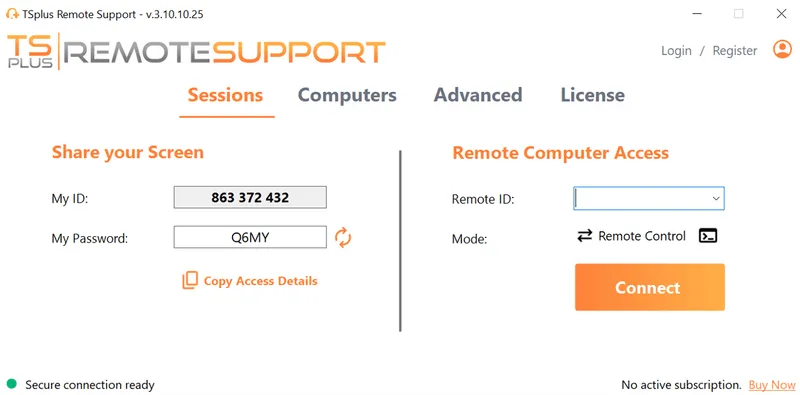)
)
What Is TeamViewer Unattended Access?
Unattended access is a remote connectivity feature that allows IT professionals to control and manage computers or servers without requiring someone on the other end to accept the session. In enterprise environments, this is essential for patch management, server maintenance, remote software installations, and emergency troubleshooting.
Overview of Unattended Access Technology
Under the hood, unattended access depends on a persistent remote access service installed on the target machine. This service keeps the device “online” within the remote access network, even when users are logged out or the machine is rebooted. Once authenticated, the remote operator can initiate a session directly.
In the case of TeamViewer :
- A static TeamViewer ID uniquely identifies each device.
- Authentication is handled either through account-based authorisation, personal static passwords, or pre-shared credentials.
- TeamViewer runs as a Windows service, enabling system-level access.
Use Cases in Professional IT Environments
- Remote server management during off-hours
- Patch deployment on unattended workstations
- Proactive monitoring and support for endpoint devices
- Device management in OT/IoT or kiosk environments
TeamViewer Unattended Access is particularly favoured for its cross-platform support (Windows, macOS, Linux, Android), but it requires careful configuration to ensure security and availability.
How Does TeamViewer Unattended Access Work?
At its core, TeamViewer Unattended Access leverages a combination of device association, network tunneling, and persistent services to establish remote control sessions.
The Role of TeamViewer ID and Static Passwords
Every TeamViewer installation generates a unique TeamViewer ID, which acts as the device’s address in the TeamViewer ecosystem. For unattended access, the remote technician connects using this ID along with:
- A static password defined during configuration, or
- Easy Access via an associated TeamViewer account with pre-approved rights.
This design ensures that devices remain accessible even after reboots or user logouts.
Always-On Service Configuration
When unattended access is enabled, TeamViewer runs as a background service (TeamViewer_Service.exe) that launches at system startup. This ensures:
- Pre-login availability: The machine can be accessed before a user logs in.
- Post-reboot persistence: Sessions can be re-established without manual intervention.
- System-level control: Useful for registry edits, driver installs, and system restarts.
This behaviour mimics that of traditional RMM agents and enterprise-grade endpoint managers.
Secure Authentication Channels
TeamViewer uses end-to-end encryption (RSA public/private key exchange and AES 256-bit session encryption) to protect session data. In unattended setups, credentials are securely stored and optionally tied to multi-factor authentication (2FA) policies for added protection.
How to Set Up TeamViewer Unattended Access
Configuring Unattended Access in TeamViewer requires a methodical approach to ensure both availability and security. Below is a detailed, technical walk-through of each step involved.
Step 1: Install the Full Version of TeamViewer
Start by installing the full version of TeamViewer on the target device—not QuickSupport, which does not support persistent services.
- Download from teamviewer.com/download
- During setup, choose “Install to control this computer later from remote”
- Allow TeamViewer to run as a system service when prompted
Tip Ensure the installer is run with administrative privileges to allow service registration.
Step 2: Create or Sign Into a TeamViewer Account
The account will be used to link devices for Easy Access.
- Open the TeamViewer client
- Click Sign In (top right) and enter your credentials
- If you don't have an account, create one and verify via email
This account becomes the key to centralized access management.
Step 3: Grant Easy Access to the Device
Once signed in:
- Click “Grant Easy Access” under the Remote Control tab
- Confirm the connection between the device and your TeamViewer account
- The device will now be visible in the Computers & Contacts panel under your account.
No password entry will be required for future connections.
Step 4: Set Up a Personal Static Password (Fallback Option)
To avoid losing access in case of account issues, define a secondary access password.
- Go to Extras > Options > Security
- Under Personal password, enter and confirm your static password
- Select an appropriate access control level (e.g., Full Access)
Make sure to store this securely in a password manager.
Step 5: Configure Startup and Service Behaviour
Enable the service to auto-launch:
- Navigate to Options > General
- Check "Start TeamViewer with Windows"
- Ensure the account has rights to run services and network communication
Firewall Considerations Ensure that outbound TCP ports 5938, 443, and 80 are not blocked, as TeamViewer uses these in that order.
Step 6: Apply Advanced Access and Security Settings
Further harden the setup by navigating to:
- Options > Advanced
- Enable black/white list access control
- Activate logging of connections
- Set two-factor authentication (2FA) under Account Security
You may also restrict access to only whitelisted TeamViewer accounts, preventing external or rogue logins.
Best Practices for Secure and Reliable Remote Access
Enabling unattended access introduces new responsibilities around compliance, uptime, and security. Here are key recommendations for production environments:
Use Device Groups and Role-Based Access
TeamViewer’s Management Console allows you to:
- Organise devices into groups (e.g., by department or region)
- Assign access levels to specific technicians or roles
- Monitor usage logs for accountability
This aligns with the principle of least privilege (PoLP) policies.
Monitor Service Health with Watchdogs
Set up a watchdog or monitoring tool to verify that the TeamViewer service is running continuously. Alerts can be configured for service interruptions or agent disconnections.
Deploy via MSI and Custom Modules (Enterprise)
For environments with many endpoints:
- Use the TeamViewer MSI package
- Configure deployment parameters via GPO or RMM
- Predefine account associations and passwords
This makes onboarding of new devices highly scalable and automatable.
Real-World Use Cases for Unattended Remote Support
Unattended access is used in a variety of IT environments. Here are some representative scenarios:
Data Centre and Server Management
Access critical infrastructure remotely to:
- Apply updates
- Restart services
- Monitor performance metrics
TeamViewer's always-on agent makes this seamless across geographies.
IT Help Desk and MSP Operations
Support endpoints without waiting for user permission:
- Install patches silently
- Run diagnostics and scripts
- Reduce support ticket resolution time
Industrial Control Systems and Kiosks
Machines in labs, manufacturing floors, or retail outlets can be:
- Accessed after hours
- Monitored continuously
- Reset or reconfigured without local user interaction
TSplus Remote Support – Efficient and Affordable Alternative
If you're looking for a simpler, more cost-effective way to provide unattended remote support without sacrificing functionality, explore TSplus Remote Support Our solution delivers all the critical features IT teams need—unattended access, secure remote control, live session management, and browser-based connectivity—combined with flexible licensing and minimal infrastructure overhead. It’s ideal for businesses that want full control of their remote support environment without the recurring costs and restrictions of traditional solutions like TeamViewer.
Conclusion
Unattended access through TeamViewer offers a powerful, flexible, and secure way for IT professionals to manage systems remotely, regardless of user presence or device location. When configured properly, it becomes an essential component of proactive IT operations—enabling silent maintenance, real-time troubleshooting, and scalable support. By integrating best practices and advanced configuration options, you can significantly improve your organization's remote access capabilities while maintaining strict control over security and compliance.

TSplus Remote Support Free Trial
Cost-effective Attended and Unattended Remote Assistance from/to macOS and Windows PCs.














)
)
)